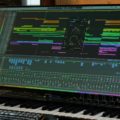 Music in Sound Design
Music in Sound Design
Music offers numerous ways to convey various emotions and settings in the realm of sound design. For instance, specific melodies and instruments can transport listeners to distinct geographical locations: tribal drums and vocals evoke Africa, majestic horns and flutes suggest the Andes mountains, and traditional oriental instruments bring Asia to mind. Music can also reflect different time periods, such as harpsichord and troubadour vocals for the Middle Ages or a clunky piano roll for the Wild West. Synth soundscapes are often associated with sci-fi or futuristic environments. While these examples may be conventional, they are generally effective in creating specific atmospheres.
Perception of music differs from that of sound effects. It is often easier to evoke emotions through melodies and instruments than with sound effects alone. Music can guide listeners to feel specific emotions, like happiness or sadness, and can even transform the overall mood. Sounds perceived as music are usually experienced more directly than sound effects, which may leave listeners pondering their origin or meaning.
Music to Evoke Imagination
Music can be divided into various genres through the use of instrumentation. Melody introduces the narrative aspect of music, consisting of notes from different scales. The overall sound is created by the instruments that represent the melody. For many people, the feeling conveyed by music comes from the combined sound of all instruments. Rhythm, provided by drums or other instruments, adds continuity and predictability to the music.
When using sound effects as a basis for evoking imagination and emotions, it’s essential to be aware of potential weaknesses. Different listeners may respond differently to a sound based on their past experiences. For example, the sound of an approaching thunderstorm may evoke a sense of relaxation for some and a feeling of danger for others. With music, creating a more precise image is often easier and leaves less to the imagination. The mental imagery that music evokes is typically more concise and focused. Fast-tempo music in a minor key often conveys thrilling and intense emotions, while slow-tempo music in a minor key can express sadness and pensiveness. Happy and lively emotions are usually associated with fast-tempo music in a major key. These basic music styles are commonly used in film and game soundtracks to elicit specific emotional responses.
Manuel Marino is a seasoned Senior Producer, Music Composer, and Artist with over a decade of experience. He specializes in branded entertainment across various mediums, including video games, films, and advertising campaigns. With 20+ years as a game music composer, Manuel has worked on numerous platforms, creating diverse orchestral soundtracks. HIRE ME


 Manuel is a passionate, driven, and techsavvy AV technician,
Manuel is a passionate, driven, and techsavvy AV technician, 









